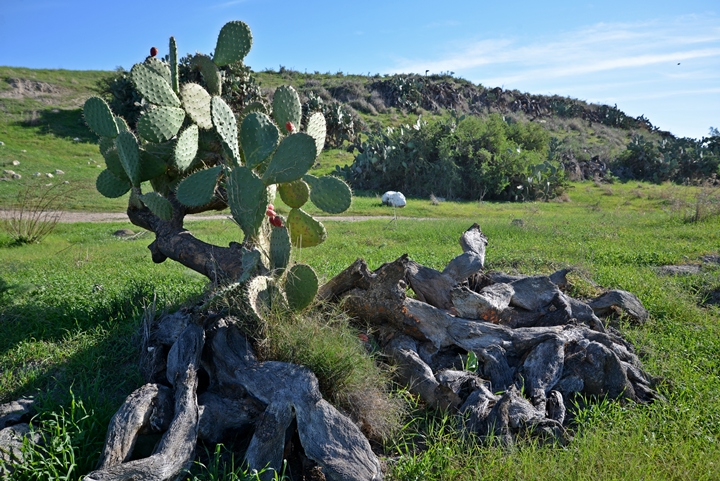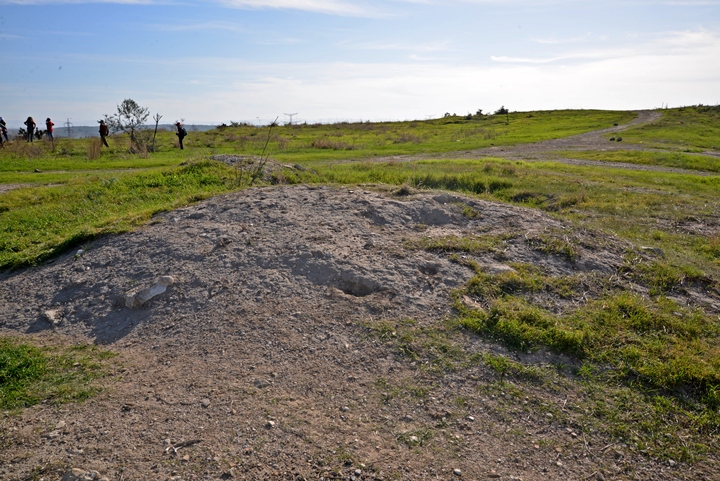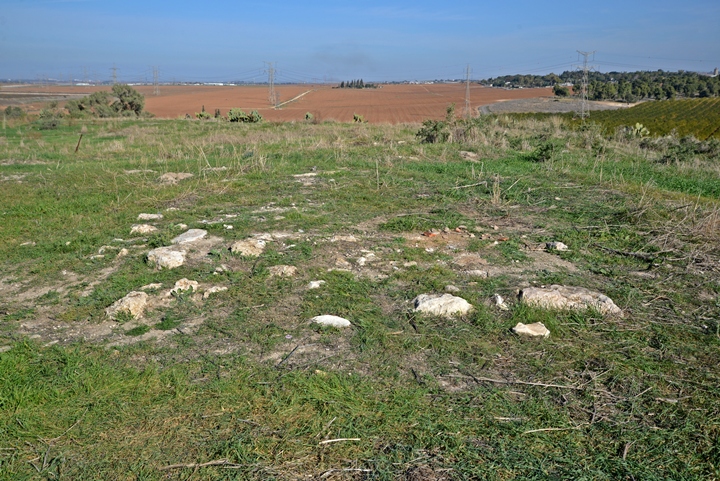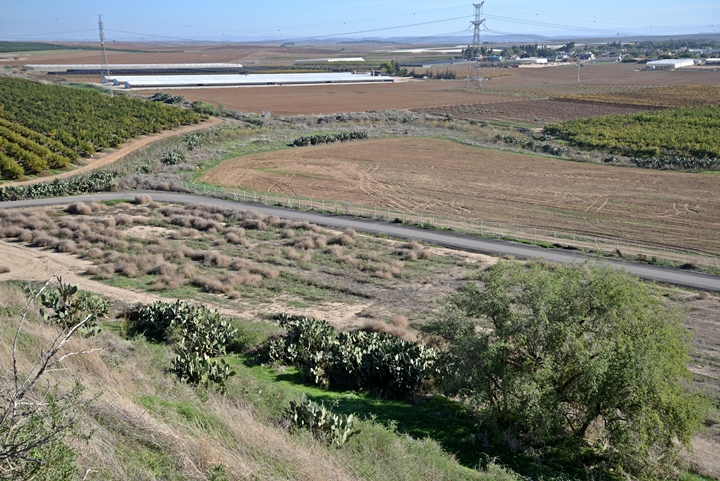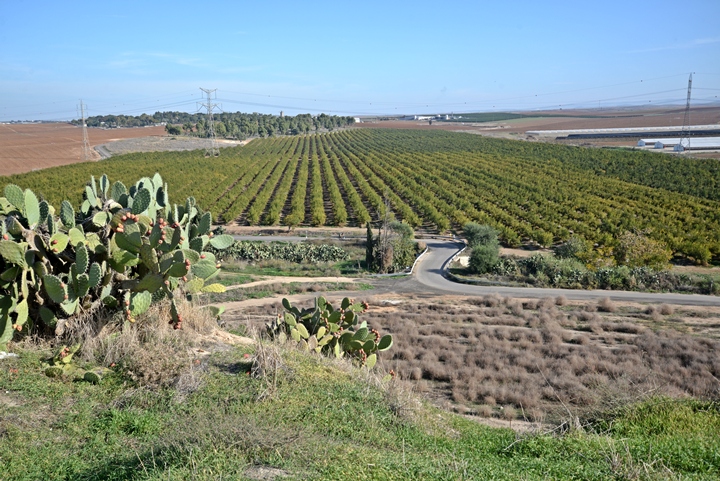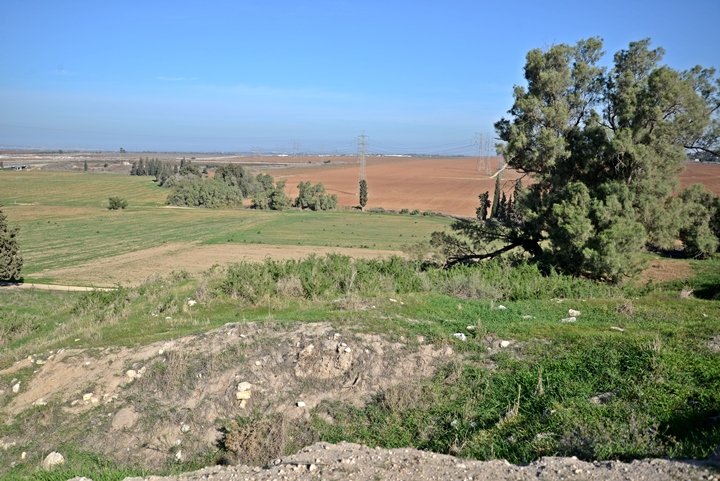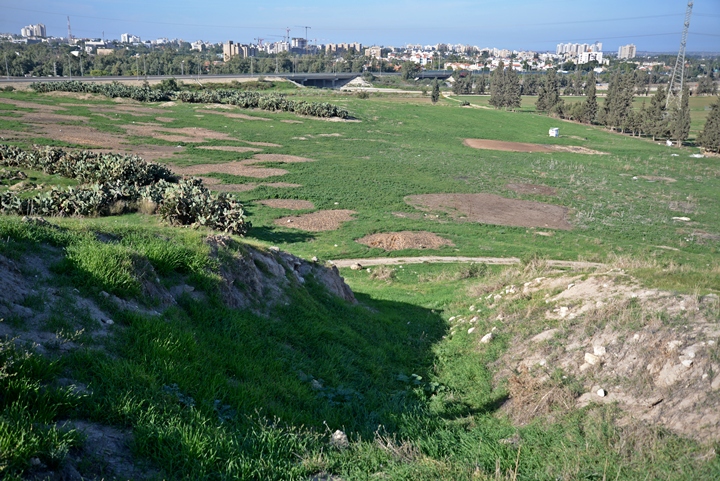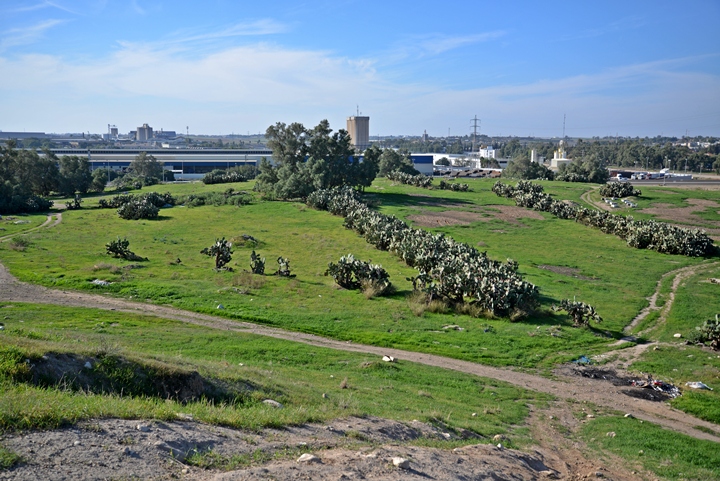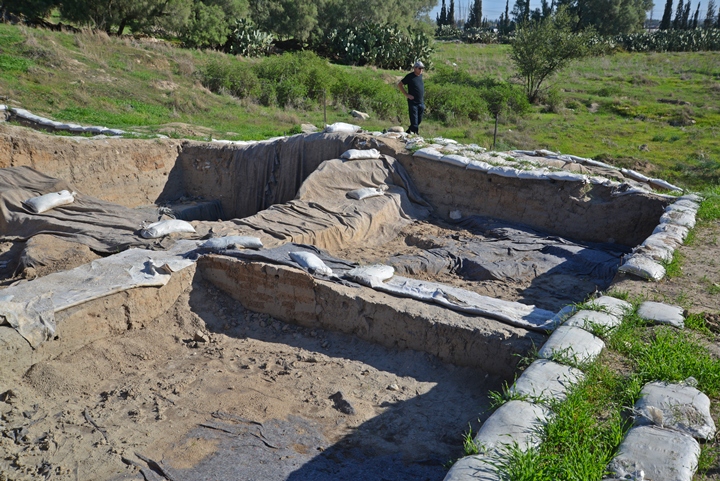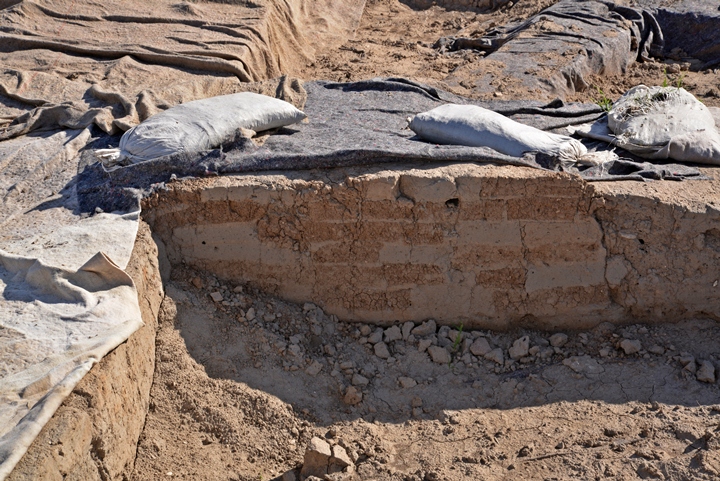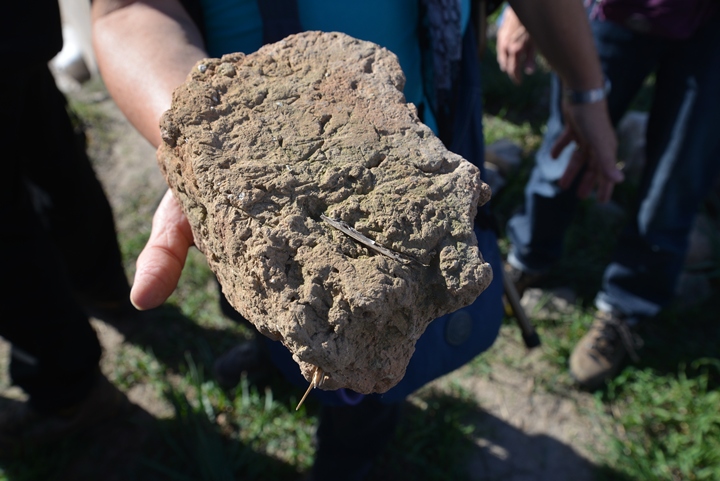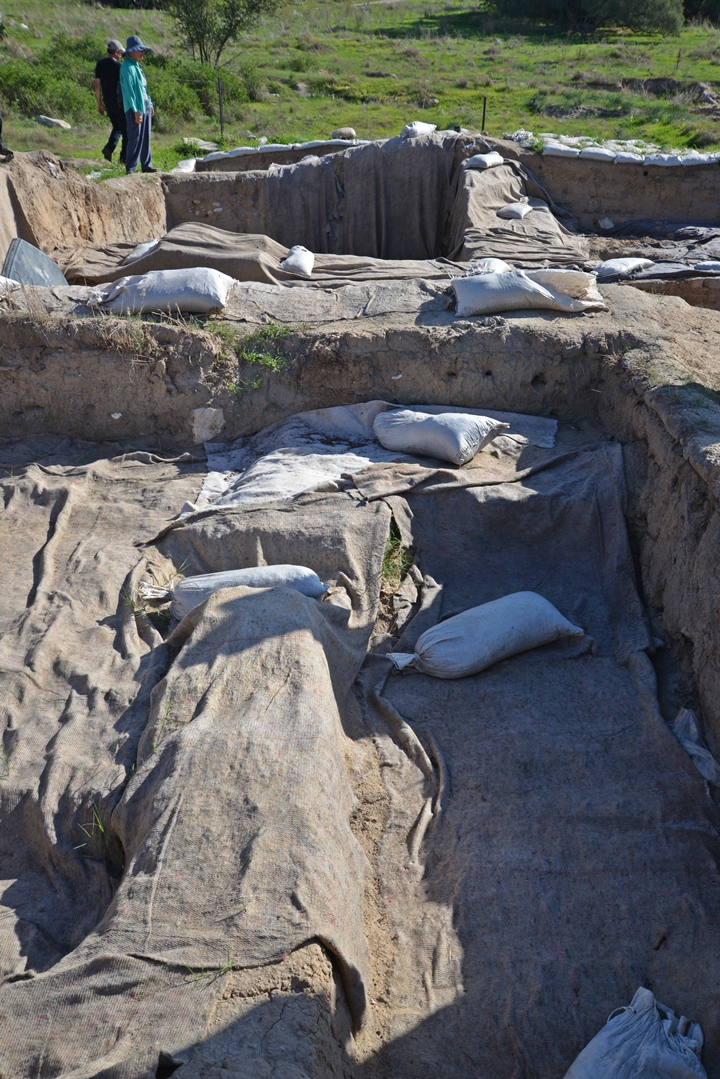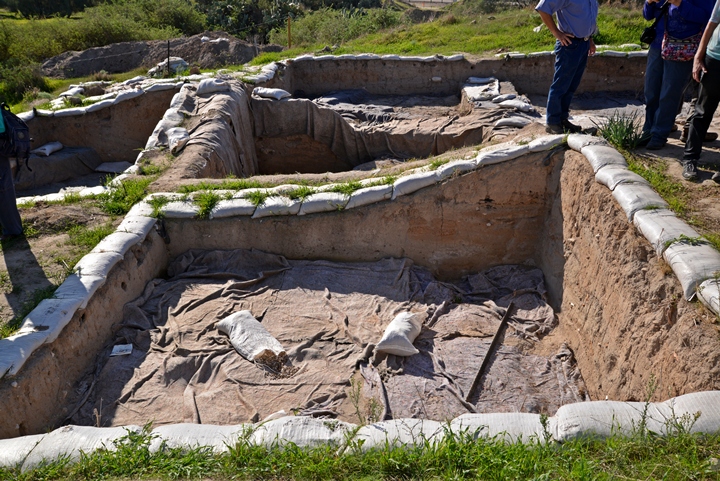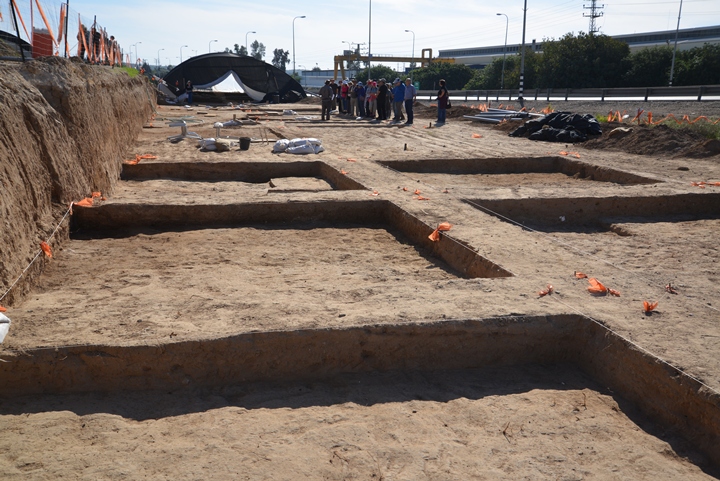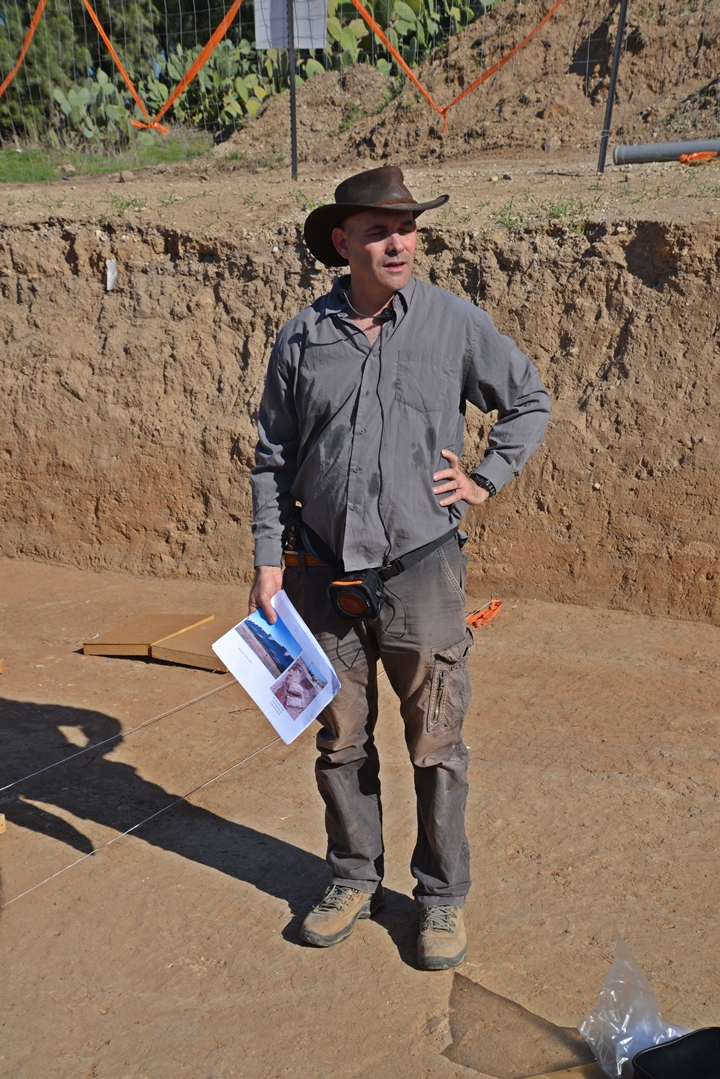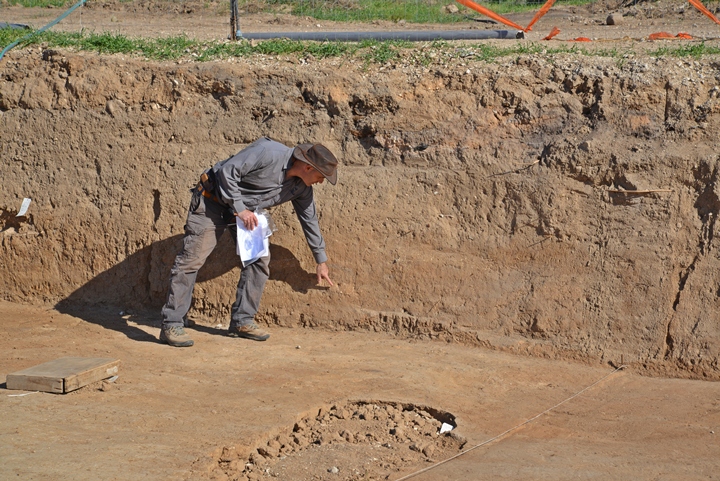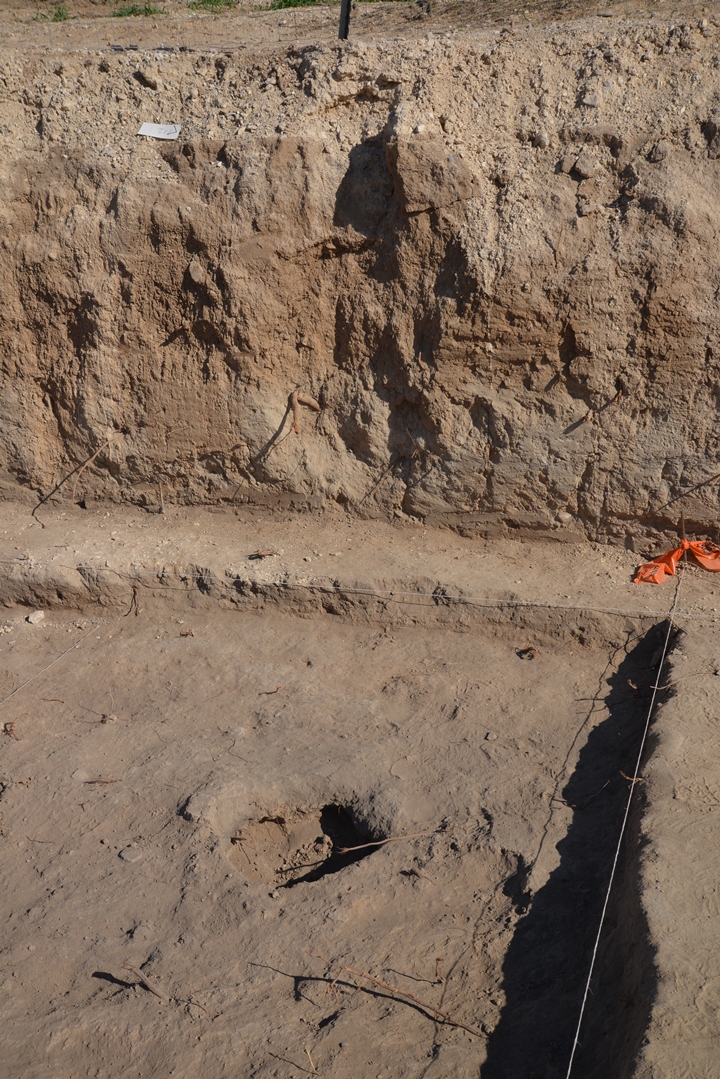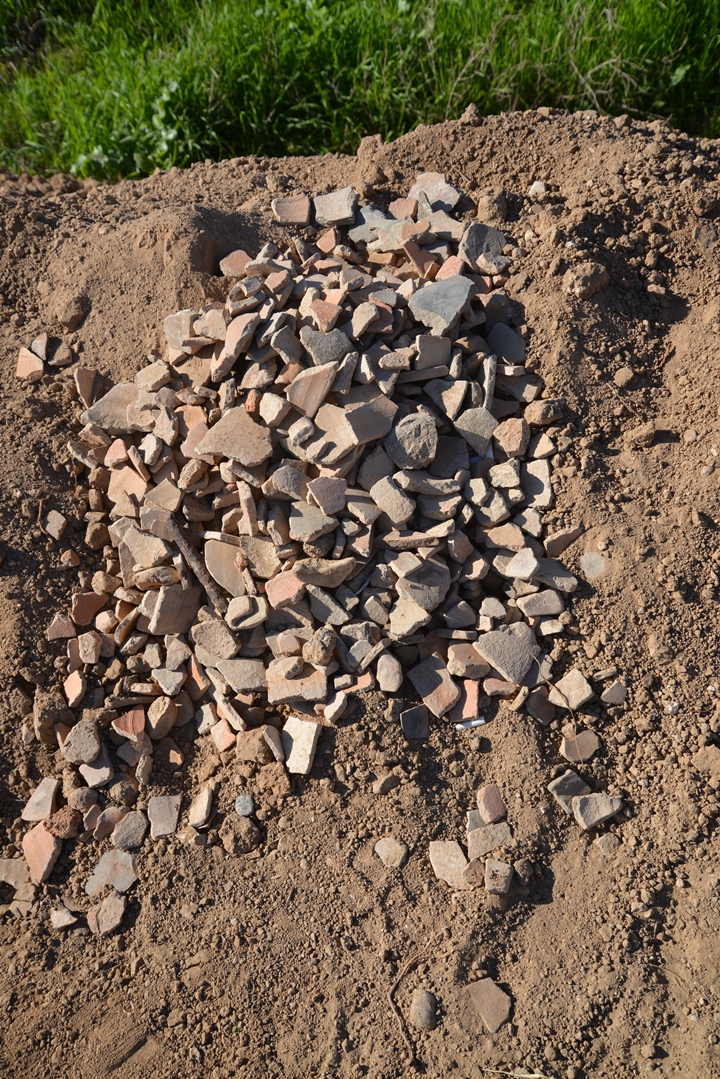Ruins of a large multi-period Canaanite city, first fortified in the Early Bronze I period.
* Site of the Month Aug 2016 *
Home > Sites > Shephela > Tel ‘Erani
Contents:
Background
Location
History
Photos
* Aerial
* Acropolis
* North East
* North West
* Upper Terrace
* Lower Terrace
* Highway #35
Etymology
Links
Background:
Ruins of a multi-period Biblical city located near Kiryat Gat, at the edge of the southern Shephela. The site consists of a lower city covering a large area of 250 dunams (25 hectares), and an upper city of 20 dunams (2 hectares) on an elevated mound at the north east corner. The city was fortified in the Early Bronze I period, more than 5,000 years ago, and was one of the major economic and commercial centers of this period in the southern Levant. Its research contributes to the understanding of the transition from the rural to urban societies in the Near East.
Location:
Tel ‘Erani is located on the eastern edge of the southern Shephela, to the south of the modern city of Kiryat Gat. It is situated on a large mound, with an elevated hill on its north east corner (20m-30m above the lower mound). The large mound consists of two terraces: an upper terrace in the west, and a lower terrace in the south.
An aerial map of the area around the site is shown here, marked with the major points of interest.
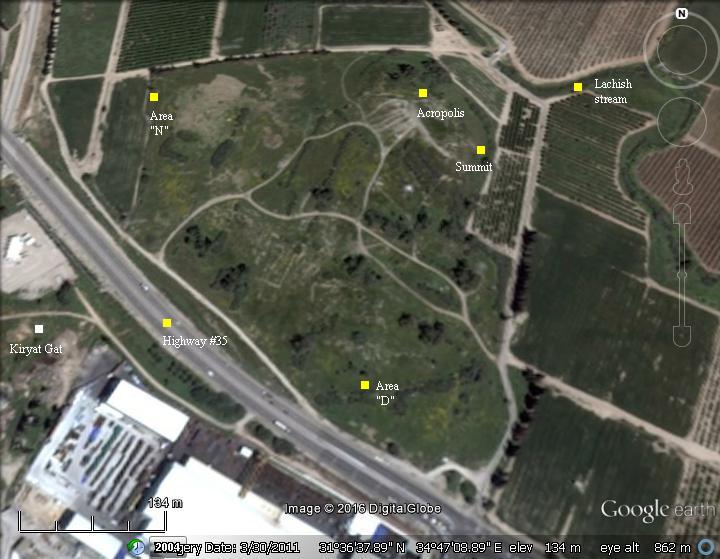
History:
-
Chalcolithic period (4,500-3,300 BC)
The first settlement was during the Late Chalcolithic period, as dated in the earliest layer. The archaeologists associated the pre-Urban settlement to the prehistoric Ghassulian culture, a Late Chalcolithic period culture in the southern Levant. It was named after the 1930s excavation of Teleilat Ghassul in the Jordan Valley, northeast of the Dead Sea. These farming people lived in small hamlet settlements, with trapezoid-shaped mud-brick houses. Most of their settlements were found in the area of Beersheba. They smelted copper for their tools, in addition to the use of ceramics and stone (Chalcolithic means: copper, based on the Greek word Chalcos).
-
Canaanite period – Early Bronze I (3,300-3050BC)
The changing political and social conditions in the Levant brought the construction of a massive fortified city at Tel ‘Erani. The urbanization – population shift from rural to urban area – started here at the end of the 4th Millennium. The major part of the city was fortified during the Early Bronze I (EB I). It was one of the major centers of the southern area of Canaan. At that time Canaan was mostly settled by small or medium-sized villages.
During the Early Bronze age Egypt and Mesopotamia were emerging as rising empires. Egypt had an impact on the process of urbanization of the city. The foundation of the city was a result of the growing Egyptian influence, as attested by the Egyptian ceramics found in the earliest layers of the fortified city (layer D in area DII). Tel ‘Erani was positioned on major trade routes between Egypt and the northern section of the Fertile Crescent (the Cradle of Civilization) – an area covering Egypt, the Levant (eastern coast of the Mediterranean Sea) and Mesopotamia. The foundation of the city preceded other large Canaanite cities that were built during the Early Bronze II period, such as Arad in the south, and Beit Shean and Dan in the north.
The structures were large and complex, probably built up to two stories high, and were constructed of thick brick walls. The plan was a central courtyard, flanked by rooms of different sizes. According to estimates, there were about 3,000-5,000 residents in the area of the walled city. According to the construction and burial methods, these people were Semitic whose culture matched the people of the north. It was ruled by a king and was one of the Canaanite city states. The entire area of the city was protected by massive fortification walls, also built with sun dried brick walls.
The city preceded the reign of Narmer (at ~3,100 BC), who is considered as the founder of unified the lower and upper Egypt, creating the first dynasty of Egypt. This timeline was based on the discovery of a serekh (facade of the royal palace) of Narmer on a ceramic piece in stratum V in area “D”, a layer later than the stratum VI of the fortification of the city. So, for the sake of comparison, the Early Bronze city on Tel ‘Erani was built some time before the great pyramids of Egypt. In other layers (VI-IV) and in other sections, Egyptian pottery types and artifacts were also found, attesting to the Egyptian influence and perhaps to the colonization by Egypt.
-
Early Bronze II-III (3,050-2,400 B.C.)
The Bronze Age city continued until the Early Bronze age III, as dated in the last layer of the Area D in the south east lower terrace. This follows a general pattern, as most of the EB III cities were depopulated in the Levant. It may have been a result of onset of drier climatic conditions, which resulted in insufficient resources to support the large cities. Most cities in the Levant disappeared and settlements were abandoned.
-
The Israelite Kingdom – Iron Age II (1000 – 586 BC)
There was a wide gap of settlement in Tel ‘Erani after it was abandoned at the end of the Early Bronze Age. Only during the Judean Kingdom period, ~1,500 years later, the city was resettled on the high point of the Acropolis. The importance of the city to the Judean kingdom was due to its strategic location: on the edge of the Shephela region, adjacent to major roads: South-North (eastern section of “Via-Maris” from Egypt to Syria) and West-East (Ashkelon and the coastal cities to Lachish, Hebron and Jerusalem). The Lachish stream on the west and north side of Tel ‘Erani also added to the defense of the city and to its water supply.
The excavators found on top of the hill 13 seals imprinted on jars with the Hebrew letters LMLK ( “L’melekh”), meaning “belonging to the king”. Some of the seals had the city of Mamshit named on the bottom (type “M2D”), with 4 Hebrew letters Mem-Mem-Shin-Tau. Other seals of Sochoh (type “S2U”) were also found here.
The majority of scholars believe these seal impressions date to the 8th-7th centuries BC, around the reign of King Hezekiah.
The finding of the seals imply that a Judean administration city was located at Tel ‘Erani.
Example of LMLK seal – Type S4L (Sochoh)
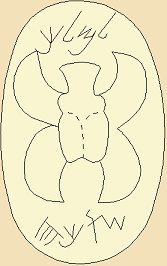
Type S4L (Sochoh)
Courtesy of LMLK.com
Recent excavations in the highway #35 section on the south side of the city revealed a new layer from the Iron Age IIa (11th-10th Century BC).
-
Assyrians (701 -610 BC)
The Assyrian empire conquered the North Kingdom of Israel in 732BC, destroying most of the cities and villages in the land. The South Kingdom of Judah managed to survive this onslaught by teaming up with the Assyrians, but not for long. After the death of the Assyrian King Sargon II (722 – 705BC), King Hezekiah mutinied against the Assyrians, joining other cities in the area who attempted to free themselves from the Assyrian conquest. Anticipating the coming Assyrian intrusion, he fortified Jerusalem and the major cities, perhaps also the city on Tel ‘Erani.
In 701 BC the Assyrians, headed by Sennacherib (ruled 704-681), invaded Israel in order to subdue it to their vast empire. The Assyrian army was lead by Sennacherib, son of Sargon II (2 Chronicles 32 1): “After these things, and the establishment thereof, Sennacherib king of Assyria came, and entered into Judah, and encamped against the fenced cities, and thought to win them for himself”.
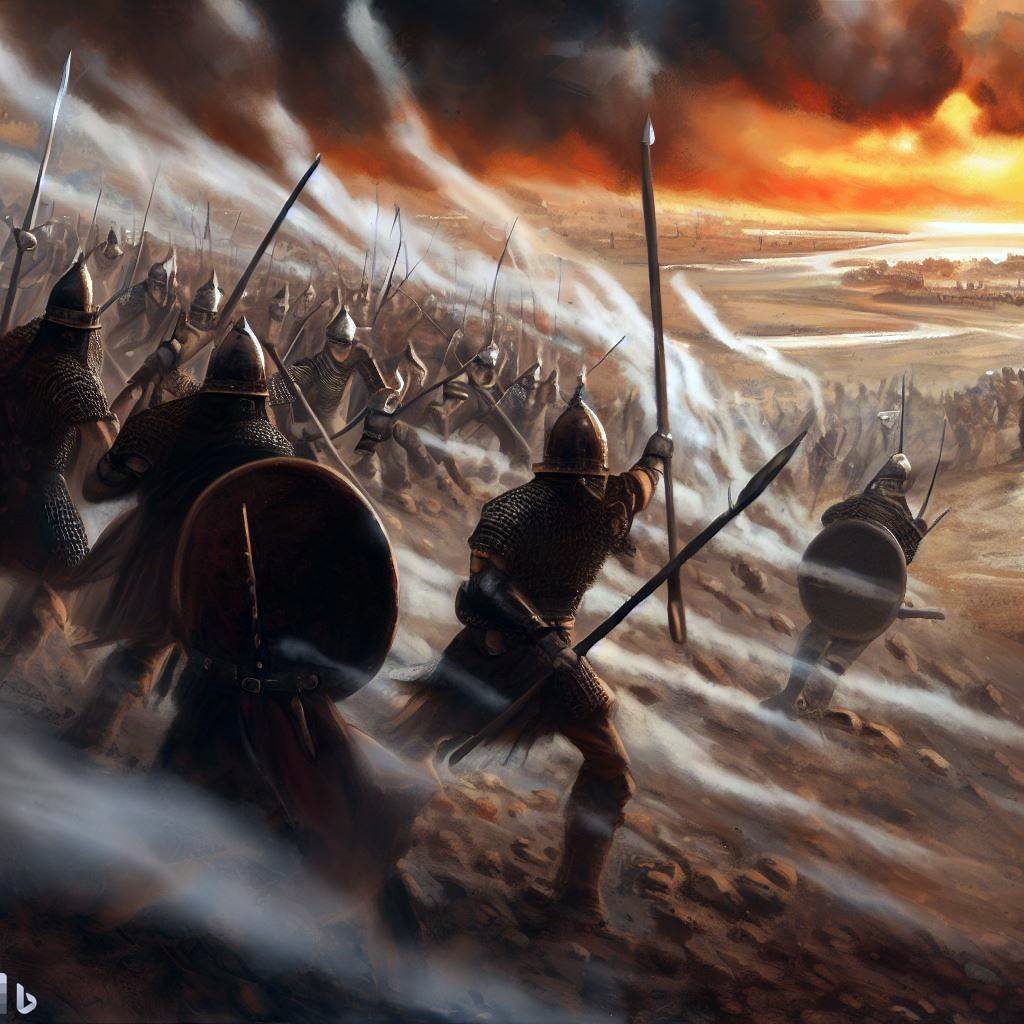
Assyrian forces attacking – AI generated by Bing
According to an Assyrian stele found in the ruins of the royal palace of Nineveh, Sennacherib conquered 46 cities in Judea:
“And as to Hezekiah, the Judaean, who had not submitted to my yoke, 46 of his strongholds, fortified cities, and smaller cities of their environs without number, with the onset of battering rams and the attack of engines, mines, breaches, and axes (?), I besieged, I captured. 200,150 people, small and great, male and female, horses, mules, asses, camels, oxen, and sheep without number I brought out of their midst and counted as booty. He himself I shut up like a caged bird in Jerusalem, his capital city; I erected beleaguering works against him, and turned back by command every one who came out of his city gate”.
After defeating an Egyptian army in Judah, the allies of King Hezekiah, Sennacherib captured dozens of cities and villages and sacked them, probably including the city on Tel ‘Erani.
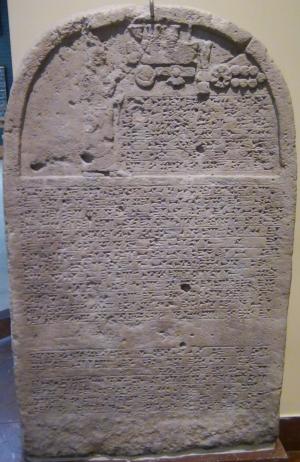
Sennacherib’s stele with relief and inscription; Nineveh;
limestone [Istanbul Archaeological Museum]
-
Persian, Hellenistic, Roman, Byzantine
During these periods, the occupation on Tel ‘Erani was mainly on the acropolis. Fortresses and structures were built on the high hill due to its location and command of the area.
-
Medieval times – Mamelukes (1260-1517)
The Mamelukes were Turkish prisoners of the Mongols who were sold to the Sultan of Egypt, trained by him and served as his palace guards. In 1250 they seized the control of Egypt, and defeated the Mongols (1260) and captured the Holy Land. According to inscriptions found on the shrine of Sheikh el ‘Areini on top of the mound, a Khan was constructed in the 14th Century on Tel ‘Erani.
The Khan (inn, caravansary) was built by Bakhtamor al-Jukhandar- the governor of their regional capital of Safed (Zefat). It was built on the side of the Mameluke “postal” road from Cairo to Damascus. This road was initiated by the first Mameluke emperor, Bybars, in 1268. It served the Mameluke empire until the 16th C.
The postal road enabled a fast connection between Cairo and Damascus, a journey taking only 4 days, thanks to the quality of the road and the stations along it.
There were dozens of Khans along the road. Examples of other stations along the road are Orkha (Juhadar) in the Golan, Qaqun, Jaljulia, Ramla and Benjamin’s tomb in the Sharon.
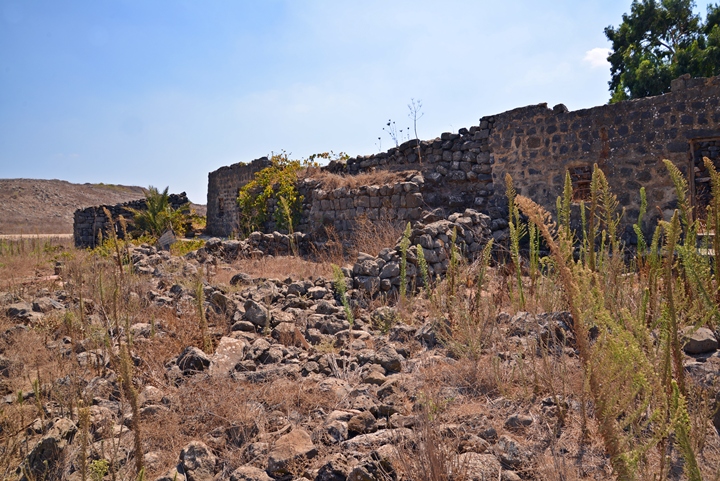
Orkha (Juhadar) in the Golan – a station along the Mameluke postal road
-
Ottoman period (1516-1918)
Conder and Kitchener surveyed this area during the Survey of Western Palestine (SWP) in 1873. A section of the survey’s map, part of Sheet 20, is shown here. Many roads (dashed lines) pass around the sites, indicating its strategic position. Two streams pass at the sides of the mound, so the site had a natural defense and supply of water.
Part of map Sheet 20 of Survey of Western Palestine,
by Conder and Kitchener, 1872-1877.
(Published 1880, reprinted by LifeintheHolyLand.com)
Their report of 1873 in Sheet XX (Volume 2, page 266) described the Arab village on the south side of the mound. They identified it as Libnah (p. 259):
“‘Arak el Menshiyeh – A mud village on a flat plain, surrounded with arable land, and supplied by three wells. It is of moderate size, with two sacred places. The curious mound north of it is a remarkable feature in the landscape, 250 feet high, and consisting of natural rock, but the sides scarped and appearing to have been artificially made steeper. On the top is a sacred Mukam, with a few hedges of prickly pear. This site is evidently ancient and important, and seems possibly to represent the ancient Libnah (Joshua xv. 42). The hills near it are of very white chalk, and the name Libnah signified ‘milk white.'”
The PEF lexicon also provided a translation of the Arabic names:
-
‘Arak el Menshiyeh – the cliff of the place of the growth
-
Sheikh Ahmed el ‘Areini – Sheikh Ahmed of the high place
-
Israeli Independence war
Fierce battles were conducted in 1948 between the Israeli Defense Forces, the Arab villagers, and the Egyptian army. Following the declaration of the state of Israel (May 15, 1948), Egyptian forces invaded into the newly declared state. They advanced in two columns – the western force advanced along the coast towards Tel Aviv, while the eastern force advanced thru this area. The eastern force was blocked here, and held a territory between the village of ‘Arak el Menshiyeh and the neighboring village of Al-Faluja, in what was called the Faluja pocket. An attempt to capture the village on Tel ‘Erani failed, with 88 dead on the Israeli side after a fierce battle inside the village. A sign commemorating the soldiers of the Alexandroni Brigade is posted on the south east side of the Tel. One of the famous senior Egyptian officers in the Faluja pocket was Gamal Abdel Nasser, who later served as the second president of Egypt. The Egyptians pulled back only in February 1949 after an armistice agreement allowed them to retreat back to the international border.
-
Excavations
The archaeologist Albright identified the site in 1921-2 as Philistine Gath, which today is identified by most scholars in another site (Tell es-Safi – Tel Tsafit, 12km north-north-east).
Excavations of Tel ‘Erani were first conducted in 1956-1961 headed by Shmuel Yevin. His excavations proved that the site was not Gath as most of the remains were of earlier dates.
The second expedition in 1985-1988 was headed by A. Kempinski and I. Gilead. The archaeologists confirmed Yevin’s conclusions and determined that “this was the earliest known urban Early Bronze center in Israel” (Kempinski, A. Kempinski and I. Gilead, p. 186).
The third expedition in 2013-2015 is headed by Y. Yekutieli.
-
Modern Times
Kiryat Gat was established in 1955 as a development town. It was named after Tel ‘Erani, as the site was known at that time to be the place of the ancient Biblical city of Gath. Within 60 years it grew to become a large city of 50,000 (2015).
The site is located in an open area, and the public is welcome to visit the site.
Photos:
(a) Aerial Views:
A drone view from the north east side of Tel ‘Erani was captured on July 2015. The center of the view is the acropolis – a high hill that towers over the ancient city on its north side. To the left of the hill is the lower city, which covers most of the area of the ancient city. The modern city of Kiryat Gat is on the far left background, to the south of highway #35. On the right side of this view is the course of Nahal Lachish stream, which flows on the north and west side of Tel ‘Erani.
![]() The following video was captured by the quadcopter over the summit, then turning around towards the south and returning back to ground on the east side.
The following video was captured by the quadcopter over the summit, then turning around towards the south and returning back to ground on the east side.
(b) Acropolis
The ruins of the city are located in two areas – an upper city (“acropolis”) on the north east corner, and the “lower” city on the remainder of the area.
The “upper” city in the ancient times was the place of the king and the noble families, while the “lower” city was inhabited by lower classes. Around the walled city were temporary dwellings by the lowest classes.
A view from the south side shows the east side of the “acropolis”.
Click on the photos to view in higher resolution…
The top of the upper city is mostly barren, except for several excavation cuts and trenches cut by the Egyptian forces during the Independence war. The findings on the summit range from the Early Bronze and Iron ages to the Ottoman period.
The highest point on the “Acropolis” is located on its east side. At this location was the shrine of the Sheikh Ahmed el ‘Areini (in Arabic – Sheikh Ahmed of the high place ). The structure of the Ottoman period shrine, now only its base is visible, was a roofless walled enclosure. Its entrance was on the north side, while a prayer niche (Mihrab) was on its southern wall. On both sides of the entrance were inscriptions that described a Mameluke Khan of Tel ‘Erani.
The high place is located just above the abyss:
(c) North East of Acropolis (Area “C”)
On the north side of the “Acropolis” is the valley of the Lachish stream. There is more than 20m difference from the top of the Acropolis (153m) to the stream – which was the major defense measure during the Bronze age.
An excavation area, designated as Area “C”, was opened on the north east foothills.
(d) North and West of the Acropolis (Areas “G”, “A”, “N”)
Area “A” was excavated at the north west side of the Acropolis and Area “G” on its foothill. A section of the excavation is seen in this photo.
The Northwest corner of the city, 200m to the west of the Acropolis, was excavated by Yeivin (1961) and designated as area “N” (below, near the lone cypress tree).
Here, massive fortification walls were uncovered. This was a surprising discovery for an Early Bronze age city. The width of the walls was 8m (!), composed of sun-dried mud bricks. The height, according to a conservative estimation, was 5-6m. A more aggressive estimation places the height at 10m or higher. This amounts to 17 million bricks that were required to surround the city, a ~1,600m long wall, at the same width and height.
The effort of placing such walls and structures in the city required a strong, hierarchical organization. It involved hundreds or thousands of laborers, skilled builders, and a whole organization that supplied food and dwellings. Only a well organized urban administration with social hierarchy could manage such project. This was a remarkable achievement for one of the first cities in the beginning of the Bronze Age.
(e) Upper terrace in the center (Areas “K”, “L”, “M”)
The upper terrace is located in the center of the area of the ruins of the Bronze Age city. This area is 20m lower than the summit, but 5-10m raised over the lower terrace on its south east side. Here, the excavators opened 3 trenches – “K”, “L” and “M”. They also found here the earliest layers of the earliest settlement.
(f) Lower terrace on South East (Area “D”)
On the lower terrace, on the south-east side of Tel ‘Erani, are excavation trenches with structures dated to the Early Bronze age.
The walls are based on sun-dried mud bricks. In the following photo the bricks are noticeable by the different tones of color.
This construction method is common in the southern Levant, in areas where stones are not found in the vicinity of the construction. Mud bricks were used for construction in both the prehistoric periods and also in the Arab villages during the Ottoman period.
Here is an example of a brick found in this area. The principal material of the mud bricks is Loess soil – a silt sized sediment that is formed by the accumulation of dust. These bricks were prepared by extracting the soil material from the ground, mixing it water, adding straw and other dry elements, pouring the mud into a wooden mold, then baking it in the sun.
Mud brick walls required periodic maintenance, adding fresh layers of mud on their external side. Furthermore, the base required to lay out a layer of stones or gravel in order to reinforce the walls.
The excavations are protected by cloth in order to preserve the mud brick walls.
The excavations revealed a large number of Bronze Age I Egyptian pottery and artifacts, attesting to the Egyptian influence and perhaps to the colonization by Egypt. The most important discovery was a serekh of Narmer on a ceramic piece in stratum V, a layer later than the stratum VI of the fortification of the city.
(g) Highway #35 excavations (2015)
The National transport infrastructure company (“Netivei Israel”) was conducting in 2015-2016 an expansion to the #35 highway along the north side of Kiryat Gat. This transportation project cut along the south walls of city, and so the Israel Antiquities Authority (IAA) was commissioned to excavate the planned route.
The archaeologists cut 6 excavation squares (5m x 5m) along the road (areas P-U), revealing the wide wall on the south side of the city. The 1m spaces between the squares allow the excavators to move between the squares, and also to mark the layers that are removed.
This tour was produced by “Tagliot” (Hebrew: Discoveries), and was directed by the archaeologist Dr. Ron Be’eri of the IAA and the University of Ben-Gurion. Ron specializes in the Canaanite period, and he participates in various excavations across the Country.
Ron points out to one of the bricks in the wall, but it is difficult to see the pattern of the bricks. This wall is another section of the Early Bronze I Age wall that was discovered in area “N”.
A closer view of the cut is below. The excavation revealed 8 settlement strata along the trenches: 5 of Early Bronze IB period and one Iron Age IB-IIA (11th-10th Century BC) were uncovered in the northern areas P & Q, and one layer dated to the Byzantine period (area U on the south).
A section of a large Iron Age cemetery, dated to the end of the Iron Age 1 and beginning of Iron Age 2 (IA-IB) was found in this excavation. The excavation exposed 46 tombs with funerary offerings buried along the graves.
Fragments of ceramics are piled on the side of the excavation. Most of the findings in this area is of the Early Bronze Age. Additional findings were storage jars in a surprising new layer of the Iron Age IIa period (11th-10th Century BC, times of the Kingdoms of David and Solomon).
Etymology (behind the name):
* Names of the site:
- ‘Arak – Arabic: cliff
- ‘Arak el Menshiyeh – the cliff of the place of the growth
- Sheikh Ahmed el ‘Areini – Sheikh Ahmed of the high place
Links and References:
* Archaeology and History:
- New Excavations at Tel Erani – Preliminary report of the 1985-1988 seasons – A. Kempinski and I. Gilead
- Salvage excavation – V. Lifshits, Hadashot Arkheologiyot, V126 Year 2014
- Tel ‘Erani – Preliminary report Hadashot Arkheologiyot 129 2017 – directed by Dmitry Yegorov and Ianir Milevski – on Road 35 excavations (areas P-U)
- Alexandroni Brigade – battle on Tel ‘Erani (Hebrew)
- Tel Erani fortifications during Early Bronze – Shalev Omer (2015), Ben Gurion Univ. MA Thesis, pdf, Hebrew. (excellent paper)
- Oldest gate found in Tel ‘Erani
* Biblewalks sites:
- Drone Aerial views – collection of Biblical sites from the air
- Gath – Philistine city, home of Goliath
- Kh. al-Ra’i – nearby Iron Age site (4km south east)
BibleWalks.com – touring the Land with the Bible in hand
Hadid<<–previous site—<<< All Sites>>>— next Shefela site–>> Gath
This page was last updated on Aug 16, 2023 (city gate found; remove panorama, change AI illst)
Sponsored links:
